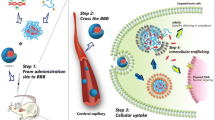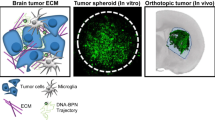Abstract
Purpose. Three different polymeric delivery systems, composed of either poly(ethylene-co-vinyl acetate) (EVAc) or poly(lactide-co-gly-colide) (PLGA), were used to administer recombinant human nerve growth factor (rhNGF) intracranially in rats.
Methods. The delivery systems were characterized with respect to release kinetics, both in the brain and in well-stirred buffer solutions.
Results. During incubation in buffered saline, the delivery systems released rhNGF in distinct patterns: sustained (EVAc), immediate (PLGA1), and delayed (PLGA2). One 10-mg delivery system was implanted in each rat and an ELISA technique was used to determine the amount of rhNGF in 1-mm coronal brain slices produced immediately after removal of the delivery system. High levels of rhNGF (as high as 60,000 ng in a brain slice of ∼50 μL) were recovered from the brain tissue at 1,2, and 4 weeks after implantation. With all three delivery systems, the amount of rhNGF in each brain slice decreased exponentially with distance from the implant site; the distance over which concentration decreased by 10-fold was 2−3 mm for all delivery systems. When rhNGF release was moderate (10 to 200 ng rhNGF/ day), the total amount of rhNGF in the brain increased linearly with release rate, suggesting an overall rate of rhNGF elimination of 0.4 hr−1 or a half-life of 1.7 hr. With higher release rates (500 to 50,000 ng rhNGF/day), total amounts of rhNGF in the brain were considerably higher than anticipated based on this rate of elimination.
Conclusions. Polymeric controlled release can provide high, localized doses of rhNGF in the brain. All of the experimental data were consistent with penetration of rhNGF through the brain tissue with a diffusion coefficient ∼8 X 10−7 cm2/s, which is ∼50% of the diffusion coefficient in water.
Similar content being viewed by others
REFERENCES
R. M. Lindsay, S. J. Wiegand, C. A. Altar, and P. S. DiStefano. Neurotrophic factors: from molecule to man. TINS 17:182–190 (1994).
W. M. Saltzman. Growth factor delivery in tissue engineering. MRS Bulletin 21:62–65 (1996).
M. J. Mahoney and W. M. Saltzman. Controlled release of proteins to tissue transplants for the treatment of neurodegenerative disorders. J. Pharm. Sci. 85:1276–1281 (1996).
E. M. Powell, M. R. Sobarzo, and W. M. Saltzman. Controlled release of nerve growth factor from a polymeric implant. Brain Res. 515:309–311 (1990).
C. E. Krewson and W. M. Saltzman. Nerve growth factor delivery and cell aggregation enhance choline acetyltransferase activity after neural transplantation. Tissue Eng. 2:183–196 (1996).
C. E. Krewson and W. M. Saltzman. Transport and elimination of recombinant human NGF during long-term delivery to the brain. Brain Res. 727:169–181 (1996).
C. E. Krewson, M. Klarman, and W. M. Saltzman. Distribution of nerve growth factor following direct delivery to brain interstitium. Brain Res. 680:196–206 (1995).
P. J. Camarata, R. Suryanarayanan, D. A. Turner, R. G. Parker, and T. J. Ebner. Sustained release of nerve growth factor from biodegradable polymer microspheres. Neurosurgery 30:313–319 (1992).
D. Maysinger, J. Filipovic-Grcic, and A. C. Cuello. Effects of coencapsulaed NGF and GM 1 in rats with cortical lesions. NeuroReport 4:971–974 (1993).
S. Yamamoto, Y. T., T. Fujita, R. Kuroda, T. Irie, K. Fujioka, and T. Hayakawa. Protective effect of NGF atelocollagen mini-pellet on the hippocampal delayed neuronal death in gerbils. Neurosci. Letters 141:161–165 (1992).
W. M. Saltzman and M. L. Radomsky. Drugs released from polymers: diffusion and elimination in brain tissue. Chem. Eng. Sci. 46:2429–2444 (1991).
T. Heya, H. Okada, Y. Ogawa, and H. Toguchi. In vitro and in vivo evaluation ofthyrotrophin releasing hormone release from copoly(dl-lactic/glycolic acid) microspheres. J. Pharm. Sci. 83:636–640 (1994).
P. A. Lapchak, D. M. Araujo, S. Carswell, and F. Hefti. Distribution of [125I] nerve growth factor in the rat brain following a single intraventricular injection: correlation with the topographical distribution oftrk A messenger RNA-expressing cells. Neuroscience 54:445–460 (1993).
K. D. Anderson, R. F. Alderson, C. A. Altar, P. S. Distefano, T. L. Corcoran, R. M. Lindsay, and S. J. Wiegand. Differential distribution of exogenous BDNF, NGF, and NT-3 in the brain corresponds to the relative abundance and distribution of high affinity and low-affinity neurotrophin receptors. J. Comp. Neurol. 357:296–317 (1995).
M. H. Tuszynski, H. S. U, K. Yoshida, and F. H. Gage. Recombinant human nerve growth factor infusions prevent cholinergic neuronal degeneration in the adult primate brain. Ann. Neurol. 30:625–636 (1991).
C. E. Krewson, R. B. Dause, M. W. Mak, and W. M. Saltzman. Stabilization of nerve growth factor in polymers and in tissues. J. Biomat. Sci. Polym. Ed. 8:103–117 (1996).
D. Maysinger, I. Jalsenjak, and A. C. Cuello. Microencapsulated nerve growth factor: effects on the forerain neurons following devascularizing cortical lesions. Neurosci. Letters 140:71–74 (1992).
C. E. Beaty and W. M. Saltzman. Controlled growth factor delivery induces differental neurite outgrowth in three-dimensional cell cultures. J. Contr. Rel. 24:15–23 (1993).
O. L. Johnson, J. L. Cleland, H. J. Lee, M. Charnis, E. Duenas, W. Jaworowicz, D. Shepard, A. Shahzamani, A. J. S. Jones, and S. D. Putney. A month-long effect from a single injection of microencapsulated human growth hormone. Nature Med. 2:795–798 (1996).
L. K. Fung, M. G. Ewend, A. Sills, E. P. Sipos, R. Thompson, M. Watts, O. M. Colvin, H. Brem, and W. M. Saltzman. Pharmacokinetics of interstitial delivery of carmustine, 4-hydroperoxycyclophosphamide, and paclitaxel from a biodegradable polymer implant in the monkey brain. Canc. Res. 58:672–684 (1998).
R. Loy, G. Taglialatela, L. Angelucci, D. Heyer, and R. Perez-Polo. Regional CNS uptake of blood-borne nerve growth factor. J. Neurosci. 39:339–346 (1994).
J. F. Poduslo, G. L. Curran, and C. T. Berg. Macromolecular permeability across the blood-nerve and blood-brain barriers. Proc. Natl. Acad. Sci. USA 91:5705–5709 (1994).
S. Yamada, M. DePasquale, C. S. Patlak, and H. F. Cserr. Albumin outflow into deep cervical lymph from different regions of rabbit brain. Am. J. Physiol. 261:H1197–H1204 (1991).
H. F. Cserr and P. M. Knopf. Cervical lymphatics, the blood-brain barrier and the immunoreactivity of the brain. Immunology Today 13:507–512 (1992).
U. Otten and R. A. Gadient. Neurotrophins and cytokines—intermediaries between the immune and nervous systems. Int. J. Dev. Neurosci. 13:147–151 (1995).
B. G. Petty, D. R. Cornblath, B. T. Adornato, V. Chaudhry, C. Flexner, M. Wachsman, D. Sinicropi, L. E. Burton, and S. J. Peroutka. The effect of systemically administered recombinant human nerve growth factor in healthy human subjects. Ann. Neurol. 36:244–246 (1994).
B. Knusel, D. R. Kaplan, and F. Hefti. Intraparenchymal NGF injections in adult and aged rats induce long-lasting TRK Tyrosine phosphorylation. Exp. Neurol. 139:121–130 (1996).
T. Naumann, P. Kermer, V. Seydewitz, R. Ortmann, F. D'Amato, and M. Frotscher. Is there a long-lasting effect of short-term nerve growth factor application on axotomized rat septohippocampal neurons? Neurosci. Letters 173:213–215 (1994).
V. E. Koliatsos, B. S. Clatterbuck, G. J. W. Nauta, B. Knusel, L. E. Burton, F. F. Hefti, W. C. Mobley, and D. L. Price. Human nerve growth factor prevents degeneration of basal forebrain cholinergic neurons in primates. Ann. Neurol. 30:831–840 (1991).
M. H. Tuszynski, H. S. U, K. Yoshida, and F. H. Gage. Recombinant human nerve growth factor infusions prevent cholinergic neuronal degeneration in the adult primate brain. Ann. Neurol. 30:625–36 (1991).
A. Lambiase, P. Rama, S. Bonini, G. Caprioglio, and L. Aloe. Topical treatment with nerve growth factor for corneal neurotrophic ulcers. N. Engl. J. Med. 338:1174–1180 (1998).
Author information
Authors and Affiliations
Corresponding author
Rights and permissions
About this article
Cite this article
Saltzman, W.M., Mak, M.W., Mahoney, M.J. et al. Intracranial Delivery of Recombinant Nerve Growth Factor: Release Kinetics and Protein Distribution for Three Delivery Systems. Pharm Res 16, 232–240 (1999). https://doi.org/10.1023/A:1018824324275
Issue Date:
DOI: https://doi.org/10.1023/A:1018824324275




